What Are Agate, Jasper and Chalcedony?
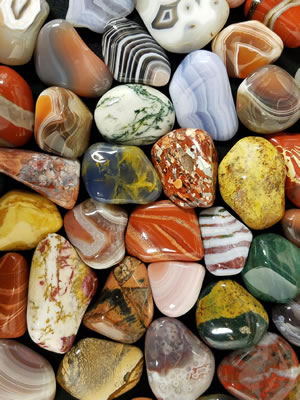
A collection of brightly colored agates and jaspers of many different kinds. All of them are "chalcedony".
What's the Difference?
If you read about the gem materials used in rock tumbling, you will encounter three names over and over again. The names are "agate," "jasper" and "chalcedony".
These names appear so often because they are the perfect materials for polishing in both rotary and vibratory rock tumblers. Here's why...
- they are able to accept a very high polish
- they are common and usually inexpensive
- they are often colorful
- they often have interesting patterns
- most importantly, they are durable enough to survive the tumbler

Although these names are often misunderstood and used incorrectly, you can easily understand them by learning a few facts. Then, you should be able to use the names correctly for most specimens.
Telling the difference between agate and jasper is easy with most specimens. However, some stones can show properties of both agate and jasper. For those specimens, you can simply call them "chalcedony" and be right every time.
Below we present a short lesson on these names to help you understand them and use them correctly - as much as that is possible.
What is Chalcedony?
Chalcedony is a generic name given to materials that are composed of microcrystalline quartz. Agate and jasper are both varieties of chalcedony.
What is microcrystalline quartz?
"Quartz" is the name of a mineral composed of silicon and oxygen (SiO2).
"Microcrystalline" means that the quartz is in the form of crystals that are so small that a microscope must be used to visualize them individually. Other types of quartz have much larger crystals - often many inches or feet across.
Chalcedony is a very hard and very durable material. That's why ancient people sought out chalcedony for making their tools and weapons (it was often called "flint"). Chalcedony has a hardness of approximately 7 on the Mohs hardness scale.
Chalcedony breaks with a conchoidal fracture, meaning its broken pieces often have smooth, curved surfaces. These freshly broken pieces of chalcedony have a dull to waxy luster. Some people find that dull to waxy luster surprising because broken pieces of quartz have a bright, vitreous luster. Why?
This luster difference is caused by the microcrystalline nature of chalcedony. When it fractures, the fracture surface must propagate across thousands of quartz microcrystals. A disturbance occurs at each crystal boundary, which causes slight irregularities on the curved fracture surfaces. Thus, much of the light that strikes chalcedony fracture surfaces is scattered instead of reflected, hence the dull or waxy luster. Now you know how to tell chalcedony from other types of quartz.
Chalcedony occurs in a wide range of colors. It is commonly gray, white, brown, red, yellow, orange and black, but it can occur in any color. It can also be banded or have plume, dendritic, mottled, mossy or other colorful structures within.
With its colorful appearance, ability to accept a bright polish, durability to survive the tumbler, ready availability, and low price, chalcedony is the perfect material for making tumbled stones.
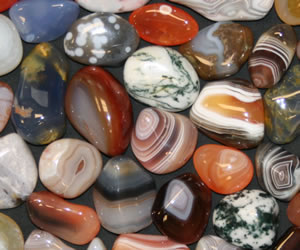
A collection of brightly-colored agates! Included in this are banded agates, plume agates, mossy agates, and eye agates in a wide variety of colors. If you are an experienced observer, you can tell that many of these specimens are translucent.
What is Agate?
Agate is a translucent to semitransparent chalcedony. If you have a piece that is semitransparent, you will be able to hold a very thin piece up to the light and see distorted or foggy images through it. If you hold a translucent piece up to a source of light, you will see a small amount of light passing through the thin edges. If you hold it up to the light and pass your hand between the material and the source of light, your hand will block the light passing through the material.
Agate is generally a banded material, and observing bands in a specimen of chalcedony is a very good clue that you have an agate. However, some agates do not have obvious bands. These are often translucent agates with plume-shaped, dendritic or mossy inclusions.
How Does Agate Form?
Many agates form in areas of volcanic activity where waters, rich in dissolved silica (SiO2), flow through fractures and cavities in igneous rocks. When the solution is highly concentrated with dissolved silica, a silica gel can form on the walls of these cavities. That gel will slowly crystallize to form microcrystalline quartz.
Over time, additional layers of gel are deposited, and these form younger bands of microcrystalline quartz on the walls of the cavity. If the dissolved mineral composition of the silica-rich water changes over time, impurities (elements other than silicon and oxygen) can be incorporated into the gel and into the microcrystalline quartz. These impurities can alter the color of the microcrystalline quartz. This can produce the color banding. Crystallization of foreign (non-silica) materials is often what forms the plumes, dendrites, or mossy structures that are often seen in translucent agate.
Although agates typically form in igneous rocks such as basalt, rhyolite, and andesite, they can also form in sedimentary rocks such as limestone. All of these types of rock are more susceptible to weathering than agate. So when the rocks are eventually broken down by weathering, the durable agates will remain. This is why agate nodules are often found in stream valleys that cut through fine-grained igneous rocks or limestone.
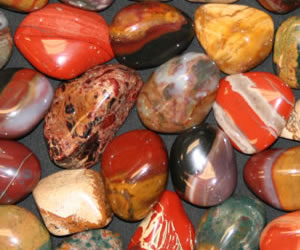
A collection of jaspers in a wide variety of patterns and colors. If you are an experienced observer, you can tell that many of these specimens are obviously opaque.
What is Jasper?
Jasper is an opaque variety of chalcedony. Opaque means that neither light nor images pass through.
Microcrystalline quartz in its pure form is semitransparent. When a small amount of impurities or foreign materials are added, the color of the microcrystalline quartz changes, and its ability to transmit light decreases. Jasper contains enough impurities and foreign material to render it opaque. So, the real difference between jasper and agate is the amount of impurities and foreign material contained with a specimen.
How Does Jasper Form?
While agate is typically a material that forms in the cavities of an igneous rock or limestone, jasper often forms when fine particulate materials are cemented by silica. This often occurs in soft sediments when silica precipitates and cements them into a solid mass. These included particles are what give jasper its color and opacity. A sedimentary material known as "chert" forms in extensive bedded deposits. It is also an opaque variety of chalcedony that can be called a "jasper".
Jaspers are also known to form when volcanic ash or fine pyroclastics are cemented into a solid material from the precipitation of silica from solution. The cementation process is sometimes so aggressive that the sediment, ash, or volcanic particles are dissolved or recrystallized into microcrystalline quartz.
The Difference Between Agate and Jasper
The primary difference between agate and jasper is in their diaphaneity. The word "diaphaneity" is used to describe "how easily light passes through a material". There are three general levels of diaphaneity. They are, from highest to lowest:
- Transparent (light and images pass through)
- Translucent (light passes through)
- Opaque (no light passes through)
The System of Assigning a Name
"Chalcedony" is a name that is based upon two things: 1) crystal size, and 2) composition. Chalcedony is a microcrystalline quartz. Easy!
"Agate" is a name based upon three things: 1) crystal size, 2) composition, and 3) diaphaneity. Agate is a microcrystalline quartz with a translucent to semitransparent diaphaneity. Easy!
"Jasper" is a name based upon three things: 1) crystal size, 2) composition, and 3) diaphaneity. Jasper is a microcrystalline quartz with an opaque diaphaneity. It is opaque because it contains enough non-chalcedony material to interfere with the passage of light. Easy.
If you have a piece of chalcedony, determining if it is an agate or a jasper is easy when that material is clearly semitransparent, translucent, or opaque. However, it can be difficult to determine the boundary between translucent and opaque. In addition, some specimens can have translucent zones and opaque zones. What are they called? Some people have solved this problem by using the term "jaspagate" or "jasper-agate" when a specimen contains zones of both jasper and agate. Anyone who is correctly using the name "jaspagate" has probably given a rock more than a casual look. :-)
An Important Difference Between Chalcedony and Quartz
An important physical property difference between chalcedony and quartz can be found by observing the luster of their conchoidal fracture surfaces. Conchoidal fracture surfaces on quartz have a vitreous (glass-like) luster, but conchoidal fracture surfaces on chalcedony have a dull or semi-vitreous luster. Why?
The fracture surfaces on chalcedony cut across a huge number of microscopic quartz crystals with boundaries and different optical orientations. This results in a scattering of light rather than a sharp reflection.
Thus, conchoidal fracture surfaces on quartz display a vitreous luster because a maximum amount of light is reflected. However, conchoidal fracture surfaces on chalcedony display a dull to semivitreous luster because much of the light that strikes them is scattered. This information will help you to separate chalcedony and many other granular or microcrystalline materials from translucent crystalline quartz.
We Aren't Trying to Muck Things Up, But You Might Want to Know....
The names "jasper" and "agate" are often used very generously and sometimes not used when they could be. Here are a few examples:
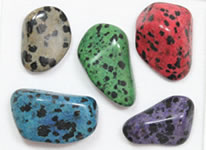
Dalmatian stone is often dyed, so if you see a stone with black spots and an outrageous color (like the blue, red, green and purple stones at right), it might be dalmatian stone.
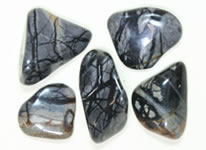
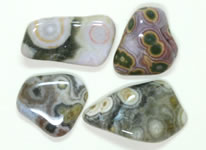
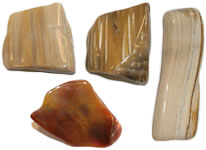
Many people don't realize that petrified wood is found at many locations from around the world. On our small rough page, we sell petrified wood from North Dakota that is specially sized for small tumbler barrels.
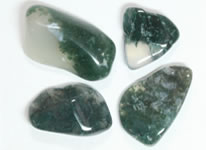
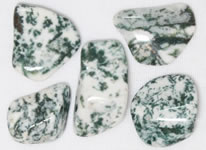
Green moss agate is a semitransparent agate with green mossy inclusions inside. Green tree agate is an opaque white jasper with green mossy inclusions inside - however, they are only visible where they are exposed at the surface.
Green moss agate and green tree "agate" have been found together in the same deposit - having formed just inches from one another. That's how closely they are related!

It is a banded material, and for that reason, some people want to call it "agate". It is also an opaque material, and for that reason, some people want to call it "jasper". However, it is neither. It is a lithified sediment that contains a volcanic brew of materials that include: volcanic ash, gypsum, barite, sulfur, and even some orpiment (an arsenic mineral!). Because it is neither jasper or agate, a better name might be "Bumblebee Stone".
Bumblebee Stone is often cut into cabochons, but much of what is cut must be stabilized with a resin because it is soft, porous, and fragile. We have also seen people get into arguments about this material because of its arsenic content - they think it should not be made into jewelry. We don't recommend it for rock tumbling because of its arsenic content and because much of it is too fragile to survive a good tumble. There are plenty of other kinds of rocks to tumble.
Happy Tumbling!
RockTumbler.com Authors
 |
Hobart M. King has decades of rock tumbling experience and writes most of the articles on RockTumbler.com. He has a PhD in geology and is a GIA graduate gemologist. He also writes the articles about rocks, minerals and gems on Geology.com. |

